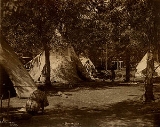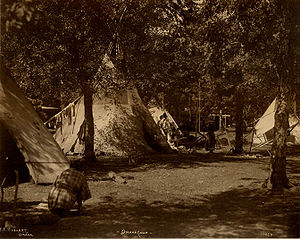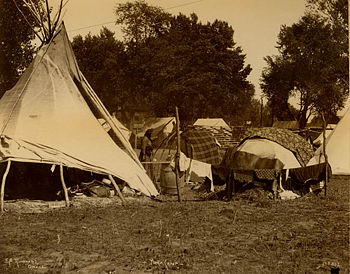
Indian Congress
Encyclopedia

Omaha, Nebraska
Omaha is the largest city in the state of Nebraska, United States, and is the county seat of Douglas County. It is located in the Midwestern United States on the Missouri River, about 20 miles north of the mouth of the Platte River...
, in conjunction with the Trans-Mississippi International Exposition. Occurring within a decade of the end of the Indian Wars
Indian Wars
American Indian Wars is the name used in the United States to describe a series of conflicts between American settlers or the federal government and the native peoples of North America before and after the American Revolutionary War. The wars resulted from the arrival of European colonizers who...
, the Indian Congress was the largest gathering of American Indian
Native Americans in the United States
Native Americans in the United States are the indigenous peoples in North America within the boundaries of the present-day continental United States, parts of Alaska, and the island state of Hawaii. They are composed of numerous, distinct tribes, states, and ethnic groups, many of which survive as...
tribes of its kind to that date. Over 500 members of 35 different tribes attended, including the Apache
Apache
Apache is the collective term for several culturally related groups of Native Americans in the United States originally from the Southwest United States. These indigenous peoples of North America speak a Southern Athabaskan language, which is related linguistically to the languages of Athabaskan...
chief Geronimo
Geronimo
Geronimo was a prominent Native American leader of the Chiricahua Apache who fought against Mexico and the United States for their expansion into Apache tribal lands for several decades during the Apache Wars. Allegedly, "Geronimo" was the name given to him during a Mexican incident...
, who was being held at Fort Sill
Fort Sill
Fort Sill is a United States Army post near Lawton, Oklahoma, about 85 miles southwest of Oklahoma City.Today, Fort Sill remains the only active Army installation of all the forts on the South Plains built during the Indian Wars...
as a United States
United States
The United States of America is a federal constitutional republic comprising fifty states and a federal district...
prisoner of war
Prisoner of war
A prisoner of war or enemy prisoner of war is a person, whether civilian or combatant, who is held in custody by an enemy power during or immediately after an armed conflict...
.
Frank A. Rinehart's photographs of the Indian Congress participants are regarded as one of the best photographic documentations of American Indian leaders at the turn of the century.
Background
After steady lobbyingLobbying
Lobbying is the act of attempting to influence decisions made by officials in the government, most often legislators or members of regulatory agencies. Lobbying is done by various people or groups, from private-sector individuals or corporations, fellow legislators or government officials, or...
by the organizing committee of the Trans-Mississippi International Exposition, in December 1897 a bill was introduced in the United States Congress
United States Congress
The United States Congress is the bicameral legislature of the federal government of the United States, consisting of the Senate and the House of Representatives. The Congress meets in the United States Capitol in Washington, D.C....
that provided an appropriation of $100,000 to carry out an Indian Congress at the same time as the Expo. After passing the Senate
United States Senate
The United States Senate is the upper house of the bicameral legislature of the United States, and together with the United States House of Representatives comprises the United States Congress. The composition and powers of the Senate are established in Article One of the U.S. Constitution. Each...
, preparations for the Spanish-American War
Spanish-American War
The Spanish–American War was a conflict in 1898 between Spain and the United States, effectively the result of American intervention in the ongoing Cuban War of Independence...
monopolized the United States House of Representatives
United States House of Representatives
The United States House of Representatives is one of the two Houses of the United States Congress, the bicameral legislature which also includes the Senate.The composition and powers of the House are established in Article One of the Constitution...
. In July 1898, $40,000 was made available for the event in the Indian Appropriations Act
Indian Appropriations Act
The Indian Appropriations Act is the name of several acts passed by the United States Congress. A considerable number of acts were passed under the same name throughout the 19th and early 20th centuries, but the most notable landmark acts consist of the 1851 Indian Appropriations Act and the 1871...
by President William McKinley
William McKinley
William McKinley, Jr. was the 25th President of the United States . He is best known for winning fiercely fought elections, while supporting the gold standard and high tariffs; he succeeded in forging a Republican coalition that for the most part dominated national politics until the 1930s...
. That was a month after the rest of the Expo opened. Funding was also made available by the Bureau of American Ethnology
Bureau of American Ethnology
The Bureau of American Ethnology was established in 1879 by an act of Congress for the purpose of transferring archives, records and materials relating to the Indians of North America from the Interior Department to the Smithsonian Institution...
, a part of the Smithsonian Institution
Smithsonian Institution
The Smithsonian Institution is an educational and research institute and associated museum complex, administered and funded by the government of the United States and by funds from its endowment, contributions, and profits from its retail operations, concessions, licensing activities, and magazines...
.
In 1898 W. A. Jones, the Commissioner of Indian Affairs, sent a letter to each Indian Agency to appeal for attendees. The purpose of the Indian Congress, as he stated, was:
About

James Mooney
James Mooney was an American ethnographer who lived for several years among the Cherokee. He did major studies of Southeastern Indians, as well as those on the Great Plains...
and Army Captain William Mercer of the 8th U. S. Infantry, under the direction of the Commissioner of Indian Affairs acting on behalf of Cornelius Newton Bliss
Cornelius Newton Bliss
Cornelius Newton Bliss was an American merchant and politician.Cornelius Bliss was born at Fall River, Massachusetts. He was educated in his native city and in New Orleans, where he early entered his stepfather's counting house...
, the United States Secretary of the Interior
United States Secretary of the Interior
The United States Secretary of the Interior is the head of the United States Department of the Interior.The US Department of the Interior should not be confused with the concept of Ministries of the Interior as used in other countries...
. The original intention of the organizing committee was to illustrate the daily life, industry and traits of as many tribes as possible. However, once the congress was open authorities realized that the average person attending the Exposition wanted to see dances, games, races, ceremonials and sham battles. Soon the main activities of the Indian Congress were re-enactments and the Ghost Dance
Ghost Dance
The Ghost Dance was a new religious movement which was incorporated into numerous Native American belief systems. The traditional ritual used in the Ghost Dance, the circle dance, has been used by many Native Americans since prehistoric times...
.
Weather
According to Captain Mercer's report, the weather "has been trying in the extreme... Most of the time we have had extreme heat accompanied by dry, hot winds, which rendered camp life anything but pleasant, the conditions being rendered somewhat worse by our location. Following close upon the heated period we have just had a week of cold, heavy rains which made the camp and life in it more disagreeable even than it was during the hot spell."Criticism
Ethnologist Mooney sought for the Congress to display customs of the various tribes. Instead, promoters erected a 5,000 seat grandstand, and arranged the tribes in re-enactments of battles. There were also concerns regarding the Indian Congress hosting a Ghost DanceGhost Dance
The Ghost Dance was a new religious movement which was incorporated into numerous Native American belief systems. The traditional ritual used in the Ghost Dance, the circle dance, has been used by many Native Americans since prehistoric times...
, particularly after the U.S. Army attacked dancers during the Wounded Knee Massacre
Wounded Knee Massacre
The Wounded Knee Massacre happened on December 29, 1890, near Wounded Knee Creek on the Lakota Pine Ridge Indian Reservation in South Dakota, USA. On the day before, a detachment of the U.S. 7th Cavalry Regiment commanded by Major Samuel M...
in 1890. However, the Ghost Dance was encouraged by the managers of the Exposition. A local newspaper reported the Ghost Dance became a popular attraction. The Ghost Dance shirt of Big Foot
Spotted Elk
Spotted Elk , , was the name of a chief of the Miniconjou Lakota Sioux. He was a son of chief One Horn and became a chief upon the death of his father. He was a highly renowned chief with skills in war and negotiations...
was displayed in another part of the Expo.
Frank A. Rinehart
Mooney contracted with Frank A. Rinehart and Adolph Muhr to take photographs of the attendees. Rinehart made several hundred pictures, regarded as one of the most complete, non-exotifyingExoticism
Exoticism is a trend in art and design, influenced by some ethnic groups or civilizations since the late 19th-century. In music exoticism is a genre in which the rhythms, melodies, or instrumentation are designed to evoke the atmosphere of far-off lands or ancient times Exoticism (from 'exotic')...
collections of Native American portraits in existence. Rinehart and Muhr took their photographs in a studio on Expo grounds.
Speaking of his photos of the Indian Congress, Merry Foresta, director of the Smithsonian Photography Initiative at the Smithsonian Institution
Smithsonian Institution
The Smithsonian Institution is an educational and research institute and associated museum complex, administered and funded by the government of the United States and by funds from its endowment, contributions, and profits from its retail operations, concessions, licensing activities, and magazines...
said, "Rinehart's portraits are really quite extraordinary and put him above the average workaday photographer who might have also made photographs for similar reasons. There were other people working, but he seems to have really, because of the quality of his work, stood apart."
Attending tribes
35 individual tribes were represented by more than 500 Indians. The tribes in attendance included the ApacheApache
Apache is the collective term for several culturally related groups of Native Americans in the United States originally from the Southwest United States. These indigenous peoples of North America speak a Southern Athabaskan language, which is related linguistically to the languages of Athabaskan...
, Arapaho, Assiniboines, Blackfoot, Cheyenne, Chippewa, Crow
Crow Nation
The Crow, also called the Absaroka or Apsáalooke, are a Siouan people of Native Americans who historically lived in the Yellowstone River valley, which extends from present-day Wyoming, through Montana and into North Dakota. They now live on a reservation south of Billings, Montana and in several...
, Flathead
Choctaw
The Choctaw are a Native American people originally from the Southeastern United States...
, Fox
Meskwaki
The Meskwaki are a Native American people often known to outsiders as the Fox tribe. They have often been closely linked to the Sauk people. In their own language, the Meskwaki call themselves Meshkwahkihaki, which means "the Red-Earths." Historically their homelands were in the Great Lakes region...
, Iowa
Iowa tribe
The Iowa , also known as the Báxoje, are a Native American Siouan people. Today they are enrolled in either of two federally recognized tribes, the Iowa Tribe of Oklahoma and the Ioway Tribe of Kansas and Nebraska....
, Kiowa, Omaha, Otoe, Ponca
Ponca
The Ponca are a Native American people of the Dhegihan branch of the Siouan-language group. There are two federally recognized Ponca tribes: the Ponca Tribe of Nebraska and the Ponca Tribe of Indians of Oklahoma...
, Pottawatomie, Sauk and Fox, Lakota, Southern Arapaho, Tonkawa
Tonkawa
The Tickanwa•tic Tribe , better known as the Tonkawa , are a Native American people indigenous to present-day Oklahoma and Texas. They once spoke the now-extinct Tonkawa language believed to have been a language isolate not related to any other indigenous tongues...
, Wichita
Wichita (tribe)
The Wichita people are indigenous inhabitants of North America, who traditionally spoke the Wichita language, a Caddoan language. They have lived in Kansas, Oklahoma, and Texas...
, and the Winnebago
Ho-Chunk
The Ho-Chunk, also known as Winnebago, are a tribe of Native Americans, native to what is now Wisconsin and Illinois. There are two federally recognized Ho-Chunk tribes, the Ho-Chunk Nation of Wisconsin and Winnebago Tribe of Nebraska....
, as well as the Santa Clara Pueblo.
Image gallery
The following pictures were all taken by Frank Rinehart and Adoph Muhrat the Indian Congress in Omaha.Additional reading
- Rydell, R. (1981) "The Trans-Mississippi and International Exposition: "To Work Out the Problem of Universal Civilization", American Quarterly, 33(5). Special Issue: American Culture and the American Frontier. (Winter) pp. 587–607.
External links
- The Indian Congress of 1898 - Photos, stories and research from the Omaha Public Library
- The Indian Congress of 1898 Photo Gallery - Portraits be Frank RinehartFrank RinehartFrank Albert Rinehart was an American artist famous for his drawings, paintings, and photographs depicting Native American personalities and scenes, especially the leaders and members of the delegations who attended the 1898 Indian Congress in Omaha.-Biography:Rinehart was born in Lodi, Illinois...

